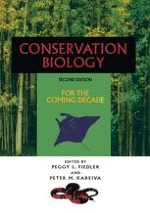1998 | OriginalPaper | Chapter
Rare Plant Demography: Lessons from the Mariposa Lilies (Calochortus: Liliaceae)
Authors : Peggy L. Fiedler, B. E. Knapp, Nancy Fredricks
Published in: Conservation Biology
Publisher: Springer US
Included in: Professional Book Archive
Activate our intelligent search to find suitable subject content or patents.
Select sections of text to find matching patents with Artificial Intelligence. powered by
Select sections of text to find additional relevant content using AI-assisted search. powered by
Rare plants have been intensively studied and described in the past two decades (e.g., Falk and Holsinger 1991; Given 1994; Frankel, Brown, and Burdon 1995; Falk, Millar, and Olwell 1996), in part due to the recovery mandates under the U.S. Endangered Species Act of 1973. The great majority of past work on rare plants has been genetic in nature (Fiedler unpublished), with demographic studies only recently becoming central to rare plant conservation. Indeed, an understanding of population dynamics along with general life history characteristics is accepted as fundamental to rare plant protection efforts, including restoration (Schemske et al. 1994; Falk, Millar, and Olwell 1996). For example, Pavlik (1994, 1995, 1996; chapter 5) has argued repeatedly that rare plant reintroduction efforts must be demographically-based, so that consequent variation in births, deaths, and fecundity can be understood in the context of individual life histories.
